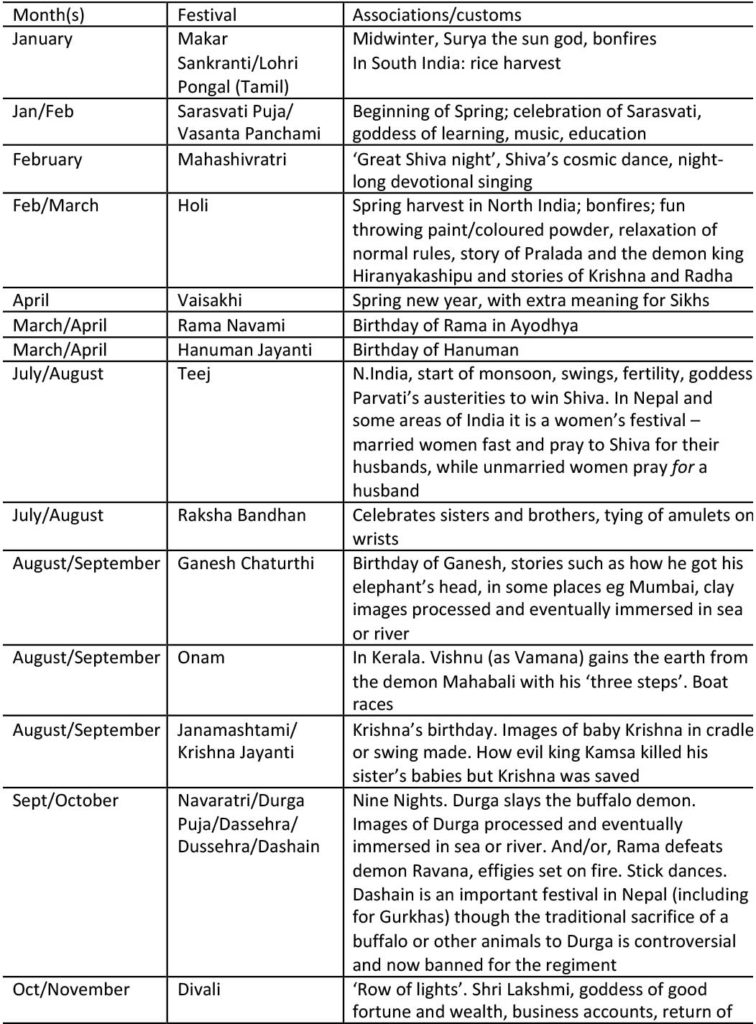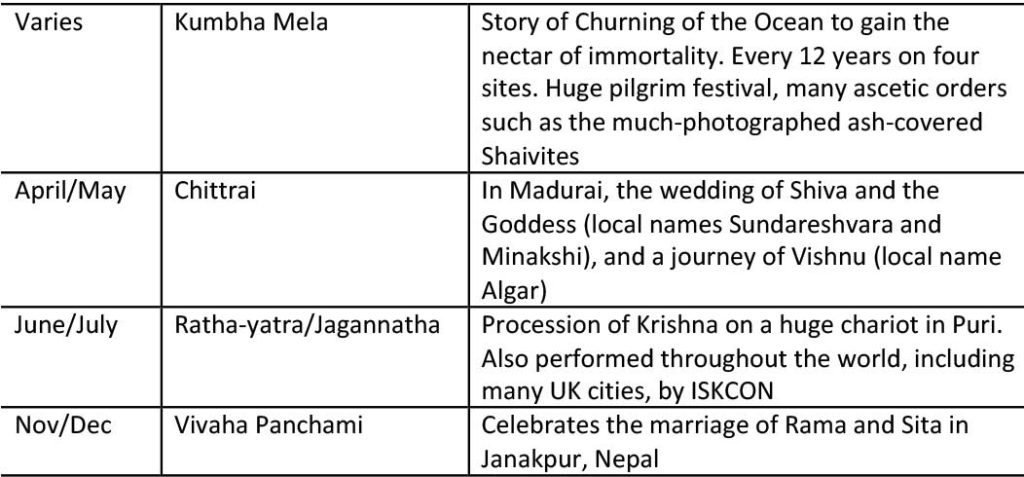Festivals (utsavas)
There are hundreds of festivals connected with the diverse Hindu tradition, some well-known throughout India (though with many regional and local variations) and the wider world, others local or regional. The difficulty of separating out the ‘religious’ and the ‘cultural’ means that what might be classed as ‘Hindu’ festivals could be classed as local cultural events. It is possible that many such events in the UK, such as Bonfire Night or the Somerset carnivals, would be classed as ‘religious’ by observers if they happened in India.
Even the calendar is plural and diverse in India. Several calendars are currently in use including the ancient (partly lunar, partly solar) ones used to calculate the dates of festivals, which are different in North and South India. As for when the year starts, there are several New Year festivals. These can be in the spring, or late summer, or autumn (Divali is seen as a New Year festival in Gujarat), and even, in earlier times, midwinter. It is a complex task to work out the corresponding dates in the Western Gregorian calendar for any festival in any particular year.
Divali (October/November) is one of the most widely celebrated Hindu festivals and has become well-known in the UK, fitting in well with an autumn term theme of ‘festivals of lights’. Cities with a substantial Hindu population may put up municipal lights for Divali and leave them up for Christmas. Associations with Divali include the triumphant return of Rama and Sita to Ayodhya, the defeat of a demon by the dwarf avatar of Vishnu, the annual visit of the Goddess Shri Lakshmi, and the meal shared by the god and goddess Yama and Yamuna. Customs include the lighting of diva (lamps), the blessing of business accounts and offerings to Lakshmi, goddess of good fortune. It can last 2-5 days. Divali is also celebrated, with similar customs but different associations, by Sikhs and Jains.
Other festivals popular in RE include Holi and Navaratri/Durga Puja. Holi is a spring festival of fun and misrule, where the normal rules of behaviour are temporarily relaxed, and the custom of throwing coloured powders at everyone has recently been adopted by some young Westerners for events unconnected with Holi. Durga Puja celebrates the victory of good over evil, personified as the buffalo demon, and in West Bengal huge images of Durga and scenes of her victory are created and processed before being immersed in a river or the sea. At the time of writing, October 2020, some creative artists have portrayed the demon as ‘Coronasura’, the Cornonavirus demon, in the hope that Durga will defeat this evil too. Another has pictured Durga herself in the form of one of the many migrant women workers who have been displaced by the pandemic, suffering terribly but keeping strong. Of course, Covid 19 measures have meant that the festival has not been able to be celebrated with the normal crowds. Unfortunately for teachers some festivals which might appeal to children such as Krishna’s birthday, Ganesh’s birthday and Raksha Bandhan often fall in the summer holidays. Sarasvati Puja, celebrating the goddess of learning, is particularly relevant for students.
Better-known festivals include the following, with indications of the time of year and (some) associations and customs, with thanks to Jackson (1998) and the Shap Calendar.
Some important festivals in particular places:
There are also annual commemorations of more recent famous Hindus such as the birthdays of Gandhi (October), Vivekananda (January) and Ramakrishna (February). Sampradayas (‘sects’) have commemorations for the founders and saints of their particular tradition.

